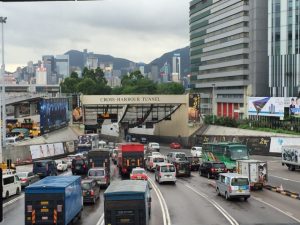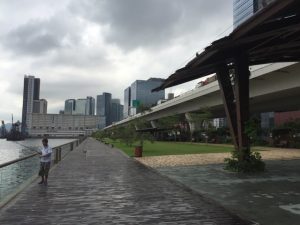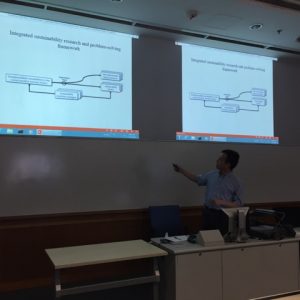
Trust me, you don’t have a problem!
I am here in Hong Kong, studying Urban Sustainability in a joint course offered by ASU and City University of Hong Kong. I am in the MPA (Master of Public Administration) program at ASU and this is my last class before I graduate. I am thrilled to wrap up my studies by applying some of the tools I’ve acquired to a real-life scenario.
Hong Kong is the perfect place to study sustainability. Over seven million people are crammed into 426 square miles. The city is a vertical city. A forest of high-rise office and residential space that dwarves the Chase Tower in downtown Phoenix. Forty percent of Hong Kong’s land is reserved for country parks and open space, which consist of mountainous terrain, lush lowlands and wetlands teeming with rich, but fragile ecosystems. Under these circumstances, Hong Kong has had no choice but to build up.
In Mong Kok, which is Hong Kong’s most populous area (and the most densely populated place on Earth), population density is 340,000 people per square mile. Compare that with Phoenix (which has about 3,200 people per square mile) and the sustainability dilemma becomes clearer.
It is in this bustling, densely populated forest of steel and concrete that we 13 students from ASU will attempt to solve the sustainability challenges that threaten its future and the livelihood and wellbeing of its inhabitants. Joined by students from City University of Hong Kong, we were divided into five groups focusing on a particular sustainability problem. Those focus areas included land use, food security, housing, transportation and conservation/biodiversity.
Scarce available land is one of the factors driving sustainability challenges in Hong Kong. The city will continue to grow, both in terms of population and economic activity. The population will grow by a million people over the next 25 years. What will not increase is available land. As a result, housing prices are astronomical. On average, a Hong Kong resident will need to work nearly 20 years, saving most of their wages, to afford a small, modest flat. Meanwhile the high population density can lead to unsanitary conditions, particularly in public housing, which has serious public health implications. Development also threatens Hong Kong’s diverse but fragile ecological landscape. With little land available for agricultural endeavors and a severe shortage of seafood, Hong Kong must import most of its food. All of these problems are, to one degree or another, tied to the land shortage.

My focus group is transportation. The team consists of myself and another MPA graduate student, as well as a Sustainability undergrad, all from ASU. Our teammate from City University is an Environmental Studies undergrad. We’ve spent the first week of the course trying to identify a transportation-related sustainability problem. I would be lying if I said that that, in itself, was not a challenge.
I come from Arizona, where efficient public transportation is next to non-existent. A car is an absolute necessity to live and function. Most of the population in the Phoenix Metro area who take the bus or our one line light rail system do so because they don’t own a car. I tried for a year to be a good citizen and took the light rail from North Central Phoenix to downtown. I quickly learned that driving to the nearest light rail station and then catching a train to downtown took twice as long as just driving to work. With a full-time job and class in the evenings, it became increasingly impractical for me to expend the extra time and effort required. Opportunity cost, as Professor Herbst taught in Economics. When I was able to get underground parking in downtown, it was “Adios, light rail!”

Hong Kong, in many ways, suffers from the exact opposite situation of Phoenix. Road congestion is a major problem here and I would consider car ownership to be more of a liability than an asset. Ninety percent of the population utilizes Hong Kong’s public transportation system, which includes the Mass Transit Railway (MTR) rail network, commuter and light buses, and light rail network. By far, it is the most efficient metro system I have ever ridden on. New York, London and Paris all have great underground rail systems. But anyone who’s ridden the New York subway knows that navigating line changes can be a challenge. The MTR, by contrast, is designed so that one often needs only disembark and walk to the other end of the platform to connect to the desired line. Genius! Compared to what we have in Phoenix (or rather, what we don’t have in Phoenix), I struggled a lot to visualize what transportation problems Hong Kong could possibly have. All I could think was “You don’t have a problem here!”

Professor Michelle Ma at City University helped us visualize and construct our problem statement. In her book, she argues that the key to building a sustainable transport system for Hong Kong lies in managing demand. Hong Kong has an ambitious plan to expand the MTR with an additional seven railway lines. Beyond that plan, the land shortage coupled with population growth poses a significant problem for future expansion. Many MTR lines are already at capacity during peak hours. Passengers often have to wait for a second or even third train due to packed cars. The bottom line is that Hong Kong cannot physically grow its public transportation system much more.
Rather than looking at ways to increase supply, therefore, the solution lies in developing policies that manage demand. If fewer people need to take public transportation, that will help balance the supply and demand equation and reduce stress on the system. With a proper problem statement now in place, the real challenge lies ahead: devising a solution.

